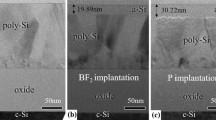Abstract
Boron-implanted silicon devices have been shown to be affected by the ambient conditions during implantation, anneal and drive-in diffusion. The presence of oxygen appears to be of major significance. This study was undertaken to observe directly by transmission electron microscopy defects existing in silicon implanted and annealed under varying conditions which might account for changes in device characteristics.
Boron ions at doses of 1013 to 1016 B+ /cm2 were implanted at 180KeV into silicon through 2000Å. thick oxide layers formed by steam at 950°C or dry oxygen at 1150°C. After implantation specimens were annealed to 950° or 1000°C for 1/2 hour periods in dry nitrogen or argon. At 950°C precipitate colonies were found in the steam-oxidized specimens and were also present in those annealed to 1000 C, whereas, to date, no such colonies were found on the specimens which had been oxidized in dry oxygen at 1150°C.
Energy dispersive x-ray analysis in an electron microscope shows that the particles contain copper and are possibly a copper suicide. Precipitation occurs only along dislocations formed on annealing the ion-damaged specimens Colonies were found as deep as 0.5μm below the oxide film. Tentatively, it is proposed that precipitation of the copper is observed only in specimens implanted through the steam formed oxide because of an increase in the number of silicon oxide nuclei due to the faster rate of oxidation. These nuclei form at dislocations and become nucleation sites for copper precipitation. The source of the copper contamination has not yet been determined.
Similar content being viewed by others
References
E. Nes and J. Washburn, J. Appl. Phys.42, 3562 (1972).
G. R. Booker and R. Stickler, Brit. J. Appl. Phys.13, 446 (1962).
E. Nes and J. Washburn, J. Appl. Phys.43, 2005 (1972).
A. G. Cullis and L. E. Katz, Phil. Mag.30, 1419 (1974).
K. V. Ravi, Metall. Trans.4, 681 (1973).
G. Das, J. Appl. Phys.44, 4459 (1973).
W. K. Tice and T. Y. Tan, Appl. Phys. Lett.28, 564 (1976).
E. Nes and J. Washburn, J. Appl. Phys.44, 3682 (1973).
P. M. Petroff, G. A. Rozgonyi and T. T. Sheng, J. Electrochem. Soc.123, 565 (1976).
T. E. Scidel, R. S. Payne, R. A. Moline, W. R. Costello, J. C. C. Tsai and K. R. Gardner, Technical Digest, IEEE Inter. Electron Devices Meeting, P. 581 (1975).
Author information
Authors and Affiliations
Rights and permissions
About this article
Cite this article
Comer, J.J., Roosild, S.A. Transmission electron microscope study of oxidation-induced. J. Electron. Mater. 6, 221–236 (1977). https://doi.org/10.1007/BF02660486
Received:
Issue Date:
DOI: https://doi.org/10.1007/BF02660486



